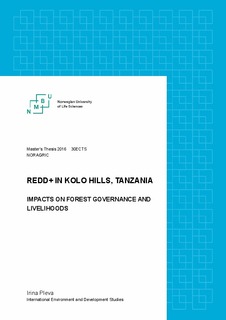| dc.description.abstract | Reduced Deforestation and Forest Degradation (REDD+) is a resource regime framework developed to enhance global carbon stocks from forests. It is based on the idea to pay national governments and rural communities of the Global South to protect and regenerate their forests for increased storage of carbon. REDD+ represents a global intervention applied as a means to mitigate climate change. In Tanzania, REDD+ has been piloted since 2010. The pilot projects across the country seek to generate experience regarding how to establish REDD+ and learn how to enhance carbon stocks as well as increase biodiversity and improve the livelihoods of forest adjacent communities. Setting up REDD+ at the local level has been a process involving many institutional changes. REDD+ demanded establishing new governance structures – actors and institutions – for managing forest resources and new alternative livelihoods for adapting to change. These changes are expected to benefit communities, protect the forests and climate. This thesis evaluates impacts from REDD+ on forest governance and livelihoods. I have conducted a case study in Kondoa district, central Tanzania, to document local experiences and assess impacts of REDD+ on people’s income and the status of forests. The REDD+ project in Kondoa has been piloted from 2010 to 2014 by the African Wildlife Foundation, covering the area around the government Kolo Hills forest reserves as well as forests on village land. The Kolo Hills is a watershed area to the Tarangire National Park and has been under protection for many years. Some parts of forests are owned by the central government, some by the local government (district), while other parts are owned and managed by the communities. Hence, the project combines emphasis on both JFM and CBFM. The primary data were collected in November 2015 using key resource person interviews, household questionnaires and focus group discussions in villages surrounding the Kolo Hills. BACI (before-after-control-impact) format is applied to compare pre-project and post-project conditions, and evaluate results against the counterfactual - the control sites which are sites where REDD+ is not introduced. Data for 2010 - pre REDD+ observations - had been collected at the time, and made available for my analysis. Acknowledging potential errors associated with the method, the study therefore investigates if changes are due to REDD+ or other factors. I develop a conceptual framework for the analysis to explain how change in the governance structures influence environmental and livelihood outcomes. The results have shown that changes in the governance structures have introduced the new type of actors and formed new institutions for managing forest resources. It implied change in property rights, as well as in rules over forest resource use. Despite these changes, I find that REDD+ in Kondoa has had no significant effect on rural livelihoods nor on deforestation. Income goes down quite substantially from 2010 till 2015. This reduction seems, however, mainly explained by a severe drought in 2014. Under various pressures of population growth, land scarcity, droughts and soil erosion, informal institutions for farming and especially livestock grazing in the government Kolo Hills reserves dominate over the introduced institutional changes under REDD+. Communities are highly aware of importance to protect their forests, however, changes in the governance structures has not addressed the core problems communities face. REDD+ institutionally seem to be more prospective under CBFM than embedded with JFM. Nevertheless, what happens when REDD+ meets realities on the ground also depend on the core foundation of a good governance in the villages it is built on. | nb_NO |

